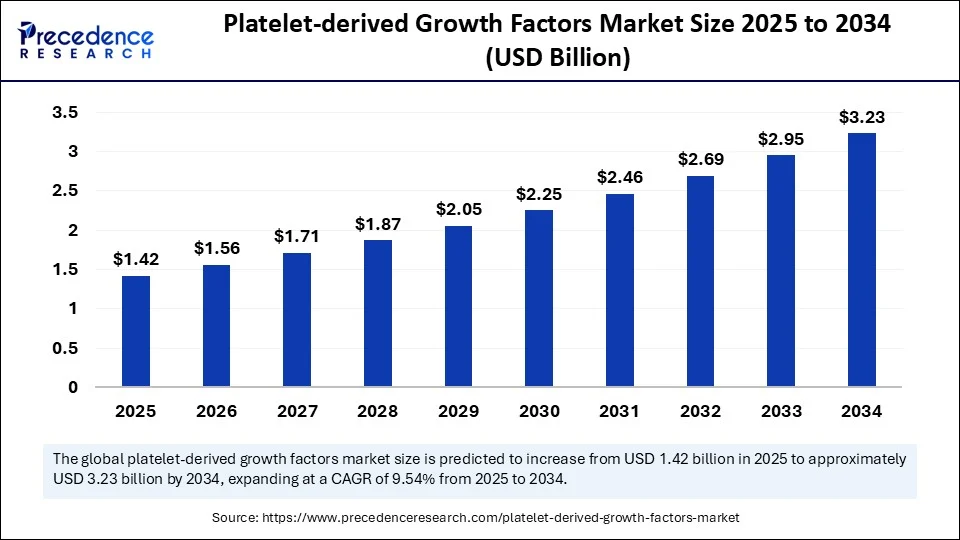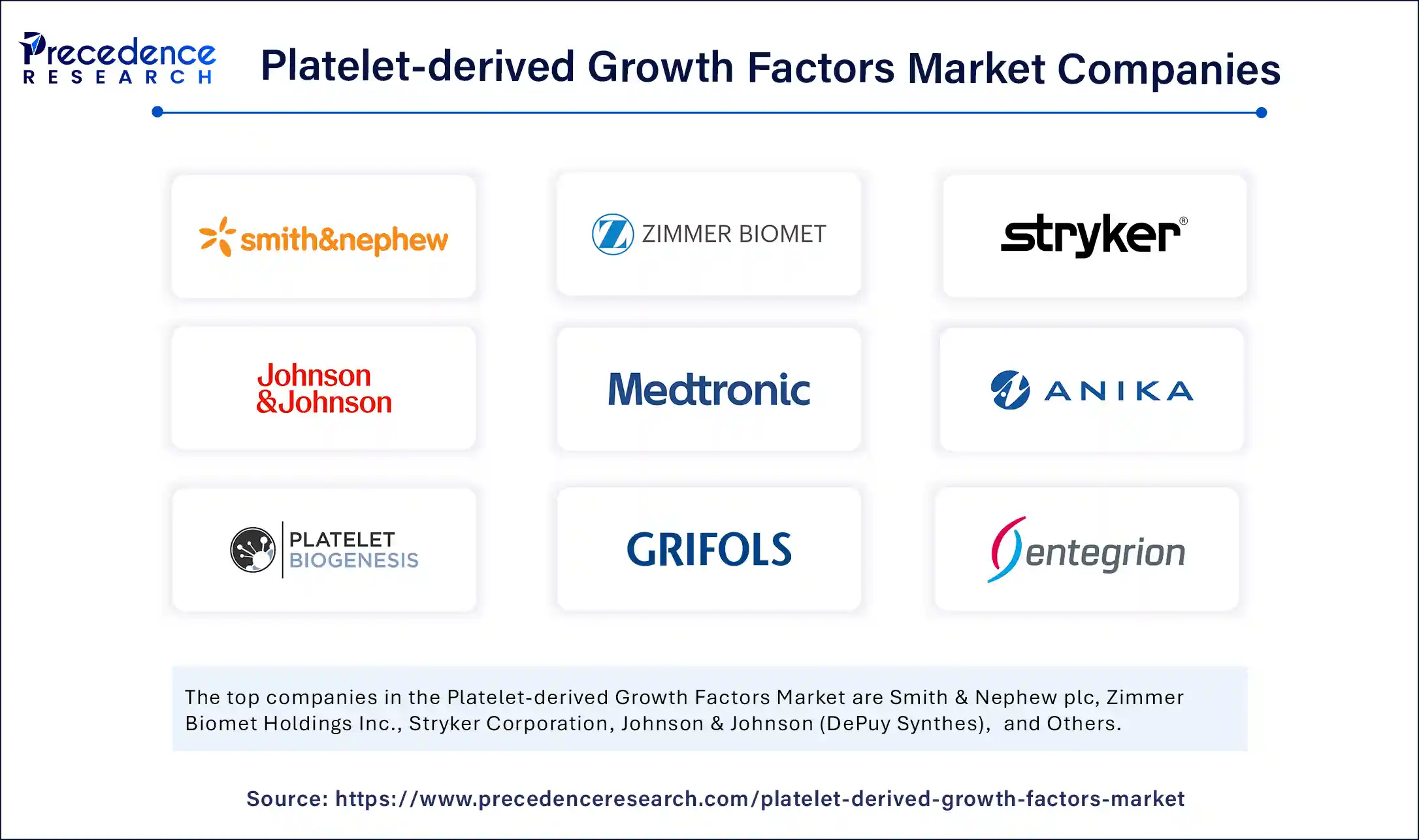
Platelet-derived Growth Factors Market Key Takeaways
- In terms of revenue, the global platelet-derived growth factors market was valued at USD 1.3 billion in 2024.
- It is projected to reach USD 3.23 billion by 2034.
- The market is expected to grow at a CAGR of 9.54% from 2025 to 2034.
- North America dominated the platelet-derived growth factors market with the largest market share of 41% in 2024.
- Asia Pacific is expected to witness the fastest growth during the forecasted years.
- By product type, the recombinant human PDGF segment held a biggest market share in 2024.
- By product type, the PDGF delivery systems segment is expected to show considerable growth over the forecast period.
- By application, the wound healing & ulcer treatment segment captured highest market in 2024.
- By application, the cosmetic & aesthetic applications segment is expected to show considerable growth over the forecast period.
- By end user, the hospitals & clinics segment contributed the highest market share in 2024.
- By end user, the specialty dermatology & aesthetic clinics segment is expected to grow at the fastest CAGR over the forecast period.
- By route of administration, the injectable segment held a significant share in 2024.
- By route of administration, the implantable/scaffold-based segment is anticipated to show considerable growth over the forecast period.
- By formulation, the gel/hydrogel formulations segment generated the major market share in 2024.
- By formulation, the others segment, especially the nanoparticle-loaded / controlled release formulations sub-segment is expected to show considerable growth in the market over the forecast period.
How is AI Integration Transforming the Platelet-derived Growth Factors Market?
In the Platelet‑derived Growth Factors Market, artificial intelligence is emerging as a driver in research and product design phases rather than direct clinical administration. Machine learning techniques are being harnessed to engineer scaffold architectures or hydrogel loading conditions for predictable PDGF release and tissue response.
Simulation-based AI and multiscale modeling—though still mostly preclinical—are enabling faster optimization of PDGF dosing and structural design in regenerative devices. These technologies promise to reduce design cycles and improve efficacy, paving the way for smarter delivery products tailored to wound or tissue specifics.
Drivers
Growth in the Platelet‑derived Growth Factors Market is powered by demographic and clinical demand: an aging population and rising chronic diseases require effective tissue repair therapies. Specifically, diabetic ulcers, cardiovascular surgery recovery, orthopedic trauma, and degenerative joint diseases elevate PDGF usage.
Innovation in biodegradable scaffold matrices, recombinant PDGF formulations, and PRP kits also enhances product consistency and clinical reproducibility. Greater acceptance in aesthetic practice for skin rejuvenation and hair restoration continues expanding the base. Finally, academic-clinical partnerships and regulatory evolution supporting biologics bolster broader adoption.
Market Trends
Current trends in the Platelet‑derived Growth Factors Market include a tilt toward PDGF‑BB dominance and preference. Clinicians and manufacturers favor injectable gel/hydrogel formats for their moisture-retention capabilities and sustained release, especially in wound care and aesthetic use. Scaffold-based implants incorporating PDGF are increasingly prescribed in orthopedic bone grafting and reconstructive surgery contexts.
Controlled-release nanoparticle and hydrogel systems offer finer-tuned dosing for chronic wounds or deep tissue repair. Certification, training, and standardization initiatives are strengthening clinician familiarity and procedural consistency, particularly in aesthetics and sports medicine.
Also Read@ https://www.pharma-geek.com/laser-capture-microdissection-market/
Opportunities
Opportunities in the Platelet‑derived Growth Factors Market include geographic expansion into Asia‑Pacific, Latin America, and Middle East & Africa where PDGF adoption is in early stages but patient need is rising. Innovations in scaffold and controlled-release delivery represent premium segments for device and biologics companies.
PDGF application beyond traditional indications—such as ophthalmology (corneal regeneration), spinal cord injury, osteonecrosis, and COVID-related lung fibrosis—offers new untapped potential. Combining PDGF with stem cell therapies, synthetic platelet analogs, or precision biomaterials presents additional avenues for pipeline innovation. Cosmetic application growth, particularly autologous treatments like PRF combined with PDGF for scar revision or facial rejuvenation, is an emerging niche.
Challenges
Challenges for the Platelet‑derived Growth Factors Market include inconsistency in autologous PRP protocols leading to variable clinical outcomes. The high cost associated with recombinant PDGF products and scaffold implants limits use in cost-sensitive healthcare environments. Lack of uniform regulation across jurisdictions complicates approval and product rollout, especially for combination biologic-device systems.
Limited large-scale clinical trials and comparative studies leave efficacy gaps in novel indications. Supply-chain complexity for biologic manufacturing and consistency in platelet isolation remain potential barriers.
Recent Developments
Recent developments in the Platelet‑derived Growth Factors Market include launch of next-gen controlled-release scaffolds embedded with PDGF designed for orthopedic bone repair and chronic wound healing. Advanced nanoparticle-release systems combining PDGF with biocompatible hydrogels enable longer dosing intervals and more predictable regeneration outcomes.
Clinics are increasingly adopting standardized training programs and certification to ensure consistent application of PDGF-based therapies in dermatology and sports medicine. New formulations combining PRF with PDGF in cosmetic treatments for skin rejuvenation and scar editing are gaining traction. Partnerships between leading biotech firms are accelerating distribution of recombinant PDGF products into emerging markets.
Platelet-derived Growth Factors Market Companies

- Smith & Nephew plc
- Zimmer Biomet Holdings Inc.
- Stryker Corporation
- Johnson & Johnson (DePuy Synthes)
- Medtronic plc
- Anika Therapeutics
- BioD LLC (part of Integra LifeSciences)
- Platelet BioGenesis
- Grifols S.A.
- Entegrion Inc.
- Thermo Fisher Scientific Inc.
- R&D Systems (Bio-Techne)
- BioWorks, Inc.
- Revmedx Inc.
- Orthocell Ltd.
- EmCyte Corporation
- Regen Lab SA
- APEX Biologix
- Terumo BCT
- TBF Genie
Segments Covered in the Report
By Product Type
- Recombinant Human PDGF (rhPDGF)
- Autologous Platelet-Derived Growth Factors (from PRP or PRF)
- PDGF Isoforms (AA, AB, BB, CC, DD)
- PDGF Assays & Detection Kits
- PDGF Delivery Systems (e.g., hydrogels, microspheres)
By Application
- Wound Healing & Ulcer Treatment
- Orthopedic & Sports Injuries
- Cosmetic & Aesthetic Applications
- Cardiovascular Repair
- Periodontal Regeneration
- Oncology (Targeted Therapy, Diagnostics)
- Others (e.g., neurodegeneration, liver regeneration)
By End User
- Hospitals & Clinics
- Research Institutes
- Biopharmaceutical Companies
- Ambulatory Surgical Centers
- Specialty Dermatology & Aesthetic Clinics
- Others
By Route of Administration
- Topical
- Injectable
- Implantable / Scaffold-Based
- Oral / Systemic (limited use)
By Formulation
- Liquid Formulations
- Gel / Hydrogel Formulations
- Powder / Lyophilized Formulations
- Others (e.g., nanoparticle-loaded PDGF)
By Region
- North America
- Europe
- Asia Pacific
- Latin America
- Middle East & Africa (MEA)
Get Sample Link@ https://www.precedenceresearch.com/sample/6522
- Estrogen Replacement Therapy Market Size to Reach USD 19.46 Billion by 2034 - September 18, 2025
- Peptide Therapeutics CDMO Market Report Size, Share & Forecast 2034 - September 17, 2025
- Rare Musculoskeletal Disorder Treatments Market Size, Share & Future Trends 2034 - September 17, 2025
